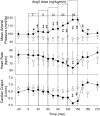Systemic angiotensin II does not increase cardiac sympathetic nerve activity in normal conscious sheep
- PMID: 30206134
- PMCID: PMC6435558
- DOI: 10.1042/BSR20180513
Systemic angiotensin II does not increase cardiac sympathetic nerve activity in normal conscious sheep
Abstract
While it is well established that centrally injected angiotensin II (Ang II) has potent actions on sympathetic nervous activity (SNA), it is less clear whether peripheral Ang II can immediately stimulate SNA. In particular, the contribution of cardiac sympathetic nerve activity (CSNA) to the acute pressor response is unknown. We therefore examined the effect of incremental doses of intravenous Ang II (3, 6, 12, 24, and 48 ng/kg/min each for 30 min) on CSNA in eight conscious sheep. Ang II infusions progressively increased plasma Ang II up to 50 pmol/l above control levels in dose-dependent fashion (P<0.001). This was associated with the expected increases in mean arterial pressure (MAP) above control levels from <10 mmHg at lower doses up to 23 mmHg at the highest dose (P<0.001). Heart rate and cardiac output fell progressively with each incremental Ang II infusion achieving significance at higher doses (P<0.001). There was no significant change in plasma catecholamines. At no dose did Ang II increase any of the CSNA parameters measured. Rather, CSNA burst frequency (P<0.001), burst incidence, (P=0.002), and burst area (P=0.004) progressively decreased achieving significance during the three highest doses. In conclusion, Ang II infused at physiologically relevant doses increased MAP in association with a reciprocal decrease in CSNA presumably via baroreceptor-mediated pathways. The present study provides no evidence that even low-dose systemic Ang II stimulates sympathetic traffic directed to the heart, in normal conscious sheep.
Keywords: angiotensins; blood pressure; sympathetic nervous system.
© 2018 The Author(s).
Conflict of interest statement
The authors declare that there are no competing interests associated with the manuscript.
Figures





Similar articles
-
Stimulation of cardiac sympathetic nerve activity by central angiotensinergic mechanisms in conscious sheep.Am J Physiol Regul Integr Comp Physiol. 2004 Jun;286(6):R1051-6. doi: 10.1152/ajpregu.00708.2003. Epub 2004 Jan 29. Am J Physiol Regul Integr Comp Physiol. 2004. PMID: 14751846
-
Low-dose B-type natriuretic peptide raises cardiac sympathetic nerve activity in sheep.Am J Physiol Regul Integr Comp Physiol. 2014 Jul 15;307(2):R206-11. doi: 10.1152/ajpregu.00404.2013. Epub 2014 May 7. Am J Physiol Regul Integr Comp Physiol. 2014. PMID: 24808496
-
Urocortin 1 exhibits potent inhibition of cardiac sympathetic nerve activity in conscious sheep.J Hypertens. 2008 Jan;26(1):53-60. doi: 10.1097/HJH.0b013e3282f01428. J Hypertens. 2008. PMID: 18090540
-
Interactions between ANG II, sympathetic nervous system, and baroreceptor reflexes in regulation of blood pressure.Am J Physiol. 1992 Jun;262(6 Pt 1):E763-78. doi: 10.1152/ajpendo.1992.262.6.E763. Am J Physiol. 1992. PMID: 1616014 Review.
-
Angiotensin II--nitric oxide interactions in the control of sympathetic outflow in heart failure.Heart Fail Rev. 2000 Mar;5(1):27-43. doi: 10.1023/A:1009894007055. Heart Fail Rev. 2000. PMID: 16228914 Review.
Cited by
-
Low-Frequency Oscillations in Cardiac Sympathetic Neuronal Activity.Front Physiol. 2020 Mar 18;11:236. doi: 10.3389/fphys.2020.00236. eCollection 2020. Front Physiol. 2020. PMID: 32256390 Free PMC article. Review.
References
Publication types
MeSH terms
Substances
LinkOut - more resources
Full Text Sources
Other Literature Sources
Research Materials
Miscellaneous

